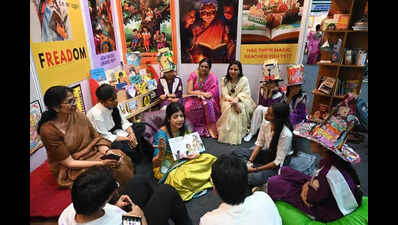New Delhi: When Nipun walked onto the stage at Thyagaraj Stadium on Friday, the packed hall of nearly 6,000 teachers fell silent for a moment. With a wave and a mechanical walk, the humanoid robot instantly broke the ice — drawing gasps, laughter and applause. In that brief greeting, Nipun became a symbol of what the Shikshak Mahakumbh — State Teachers’ Awards 2025 was all about: blending tradition with innovation and reimagining the future of education in Delhi. The Mahakumbh, organised on the Teachers’ Day, was more than just an award ceremony to honour 123 outstanding teachers. It was a full-scale showcase of Delhi’s educational journey, with 11 vibrant stalls, immersive exhibits and hands-on demonstrations. From vocational skills to language labs, inclusive education to cultural heritage, each corner of the stadium offered a glimpse into how schools are preparing students not just for exams, but for life. The event brought together Union education minister Dharmendra Pradhan, chief minister Rekha Gupta, Delhi education minister Ashish Sood and other dignitaries, who interacted with teachers and students. Children’s cultural performances in honour of their teachers added warmth to the celebration. Pradhan lauded Delhi’s education system for moving in the right direction, calling India’s guru-shishya tradition “ancient and glorious”. Teachers, he said, are not just knowledge-givers but the chief architects of nation-building. Citing former Presidents Sarvepalli Radhakrishnan and APJ Abdul Kalam, he described teachers as the society’s backbone, shaping the values of generations. CM called teaching a divine mission beyond careers and employment. “Teachers are engaged in the noble task of nation-building. Every child shaped by their hands brings pride to society and the nation,” Gupta said. Sood outlined govt’s reform roadmap, promising swift implementation. Within three years, every Delhi school and child will be part of Nipun Sankalp Mission, and within four years, classrooms from grades IX to XII will be converted into smart classrooms, he said. With AI-enabled tools, Sood added, education would become more personalised, learning outcomes better tracked and dropouts predicted early. One of the busiest spaces was the CM Shri stall, where students brought creativity to life with clay murals, wire sculptures and caricature sketches. Just across the aisle, Aryan and Naitik of Government Boys Senior Secondary School, Hari Nagar, turned discarded bulbs and wires into delicate butterflies. Their classmate Tausif, pencil in hand, sketched quietly while art teachers from the directorate of education added a professional edge to the exhibition. The library and inclusive education branch created a world of stories. Children in paper hats laughed and shouted answers as teachers led interactive storytelling sessions. Puppets and doll houses demonstrated how simple tools could unlock learning for every child. Namit, a Class VI student with mild autism, worked with his mentor on a story through puppets. “We’ve been working together for three years and his sketches are amazing,” said clinical psychologist Aastha Kapoor. At the vocational stall, the rhythm of hammers and the buzz of tools drew a steady crowd. Gaurav and Piyush from Sarvodaya Vidyalaya, Rouse Avenue, carefully crafted a wooden frame. “When we started doing practical, it became fun,” one of them said, reflecting how hands-on learning had changed his approach towards school. A few steps away, Class X student Hiba Mariyam demonstrated blood pressure and BMI checks with quiet confidence. “I want to be a doctor,” she said, her eyes shining with determination. The EVG Bureau stall highlighted the athletic spirit of Delhi’s schools. “We even have poles for athletics and our school performed well in Delhi Olympics last year,” said Disha, a Class X student, before showcasing her mallakhamba skills. Meanwhile, the language lab opened doors to the world, with teenagers enthusiastically practising Spanish, French, Japanese and German. The Samagra Shiksha stall added a technological edge, with students showing how drones could deliver medicines. A group of performers staged a mime on depression and hope, reminding the audience that education must nurture mental well-being as much as academic skill. By the end of the day, the stadium felt like a living canvas of Delhi’s schools, where creativity, inclusivity, technology and tradition all converged. At its heart, Nipun’s wave still lingered: a greeting from the future, shaped by the hands of today’s teachers and students.











